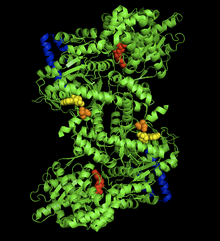Glycogen phosphorylase
| Phosphorylase | |||||||||
|---|---|---|---|---|---|---|---|---|---|

The crystal structure of the rabbit muscle glycogen phosphorylase-AMP complex. AMP allosteric site (yellow), phosphorylated Ser14 (orange), glycogen binding site (blue), catalytic site (red).
|
|||||||||
| Identifiers | |||||||||
| EC number | 2.4.1.1 | ||||||||
| CAS number | 9035-74-9 | ||||||||
| Databases | |||||||||
| IntEnz | IntEnz view | ||||||||
| BRENDA | BRENDA entry | ||||||||
| ExPASy | NiceZyme view | ||||||||
| KEGG | KEGG entry | ||||||||
| MetaCyc | metabolic pathway | ||||||||
| PRIAM | profile | ||||||||
| PDB structures | RCSB PDB PDBe PDBsum | ||||||||
| Gene Ontology | AmiGO / EGO | ||||||||
|
|||||||||
| Search | |
|---|---|
| PMC | articles |
| PubMed | articles |
| NCBI | proteins |
| phosphorylase, glycogen; muscle (McArdle syndrome, glycogen storage disease type V) | |
|---|---|
| Identifiers | |
| Symbol | PYGM |
| Entrez | 5837 |
| HUGO | 9726 |
| OMIM | 608455 |
| RefSeq | NM_005609 |
| UniProt | P11217 |
| Other data | |
| EC number | 2.4.1.1 |
| Locus | Chr. 11 q12-q13.2 |
| phosphorylase, glycogen; liver (Hers disease, glycogen storage disease type VI) | |
|---|---|
| Identifiers | |
| Symbol | PYGL |
| Entrez | 5836 |
| HUGO | 9725 |
| OMIM | 232700 |
| RefSeq | NM_002863 |
| UniProt | P06737 |
| Other data | |
| EC number | 2.4.1.1 |
| Locus | Chr. 14 q11.2-24.3 |
| phosphorylase, glycogen; brain | |
|---|---|
| Identifiers | |
| Symbol | PYGB |
| Entrez | 5834 |
| HUGO | 9723 |
| OMIM | 138550 |
| RefSeq | NM_002862 |
| UniProt | P11216 |
| Other data | |
| EC number | 2.4.1.1 |
| Locus | Chr. 20 p11.2-p11.1 |
Glycogen phosphorylase is one of the phosphorylase enzymes (EC 2.4.1.1). Glycogen phosphorylase catalyzes the rate-limiting step in glycogenolysis in animals by releasing glucose-1-phosphate from the terminal alpha-1,4-glycosidic bond. Glycogen phosphorylase is also studied as a model protein regulated by both reversible phosphorylation and allosteric effects.
Glycogen phosphorylase breaks up glycogen into glucose subunits (see also figure below):
(α-1,4 glycogen chain)n + Pi ⇌ (α-1,4 glycogen chain)n-1 + α-D-glucose-1-phosphate.
Glycogen is left with one fewer glucose molecule, and the free glucose molecule is in the form of glucose-1-phosphate. In order to be used for metabolism, it must be converted to glucose-6-phosphate by the enzyme phosphoglucomutase.
Although the reaction is reversible in solution, within the cell the enzyme only works in the forward direction as shown below because the concentration of inorganic phosphate is much higher than that of glucose-1-phosphate.
Glycogen phosphorylase can act only on linear chains of glycogen (α1-4 glycosidic linkage). Its work will immediately come to a halt four residues away from α1-6 branch (which are exceedingly common in glycogen). In these situations, a debranching enzyme is necessary, which will straighten out the chain in that area. In addition, the enzyme transferase shifts a block of 3 glucosyl residues from the outer branch to the other end, and then a α1-6 glucosidase enzyme is required to break the remaining (single glucose) α1-6 residue that remains in the new linear chain. After all this is done, glycogen phosphorylase can continue. The enzyme is specific to α1-4 chains, as the molecule contains a 30-angstrom-long crevice with the same radius as the helix formed by the glycogen chain; this accommodates 4-5 glucosyl residues, but is too narrow for branches. This crevice connects the glycogen storage site to the active, catalytic site.
...
Wikipedia
